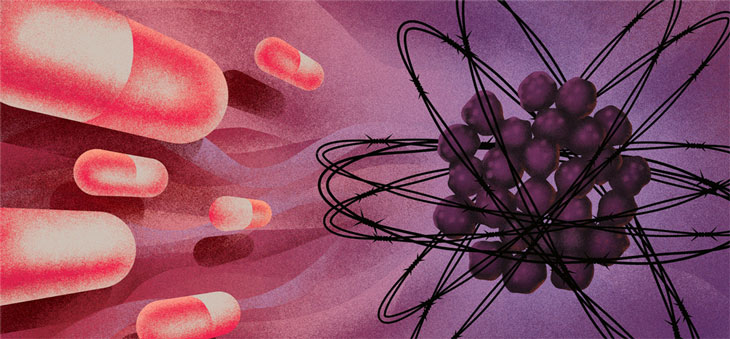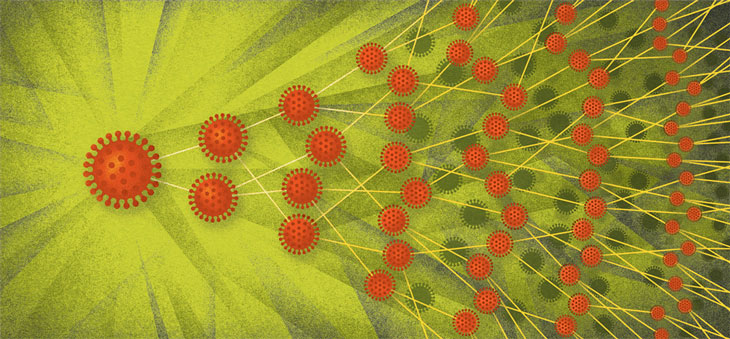Here are 5 RNAs that are stepping out of DNA’s shadow
These molecules play crucial roles in human health and disease

POWERFUL STUFF No longer seen as just a messenger for DNA, ribonucleic acid in its many forms can influence cancer, protect against viruses and defend the brain from illness.
James Provost
DNA is the glamour molecule of the genetics world. Its instructions are credited with defining appearance, personality and health. And the proteins that result from DNA’s directives get credit for doing most of the work in our cells. RNA, if mentioned at all, is considered a mere messenger, a go-between — easy to ignore. Until now.
RNAs, composed of strings of genetic letters called nucleotides, are best known for ferrying instructions from the genes in our DNA to ribosomes, the machines in cells that build proteins. But in the last decade or so, researchers have realized just how much more RNAs can do — how much they control, even. In particular, scientists are finding RNAs that influence health and disease yet have nothing to do with being messengers.
The sheer number and variety of noncoding RNAs, those that don’t ferry protein-building instructions, give some clues to their importance. So far, researchers have cataloged more than 25,000 genes with instructions for noncoding RNAs in the human genome, or genetic instruction book (SN: 10/13/18, p. 5). That’s more than the estimated 21,000 or so genes that code for proteins.
Those protein-coding genes make up less than 2 percent of the DNA in the human genome. Most of the rest of the genome is copied into noncoding RNAs, and the vast majority of those haven’t been characterized yet, says Pier Paolo Pandolfi of Boston’s Beth Israel Deaconess Medical Center. “We can’t keep studying just two volumes of the book of life. We really need to study them all.”
Scientists no longer see the RNAs that aren’t envoys between DNA and ribosomes as worthless junk. “I believe there are hundreds, if not thousands, of noncoding RNAs that have a function,” says Harvard University molecular biologist Jeannie Lee. She and other scientists are beginning to learn what these formerly ignored molecules do. It turns out that they are involved in every step of gene activity, from turning genes on and off to tweaking final protein products. Those revelations were unthinkable 20 years ago.
Back in the 1990s, Lee says, scientists thought only proteins could turn genes on and off. Finding that RNAs were in charge “was a very odd concept.”
Here are five examples among the many noncoding RNAs that are now recognized as movers and shakers in the human body, for good and ill.

lncRNAs
Foiling cancer treatment
Sometimes anticancer drugs stop working for reasons researchers don’t entirely understand. Take the chemotherapy drug cytarabine. It’s often the first drug doctors prescribe to patients with a blood cancer called acute myeloid leukemia. But cytarabine eventually stops working for about 30 to 50 percent of AML patients, and their cancer comes back.
Researchers have looked for defects in proteins that may be the reason cytarabine and other drugs fail, but there still isn’t a complete understanding of the problem, Pandolfi says. He and colleagues now have evidence that drug resistance may stem from problems in some of the largest and most bountiful of the newly discovered classes of RNAs, known as long noncoding RNAs. Researchers have already cataloged more than 18,000 of these “lncRNAs” (pronounced “link RNAs”).
Pandolfi and colleagues investigated how some lncRNAs may work against cancer patients who are counting on chemotherapy to fight their disease. “We found hundreds of new players that can regulate response to therapy,” he says.
When the researchers boosted production of several lncRNAs in leukemia cells, the cells became resistant to cytarabine, Pandolfi and colleagues reported in April 2018 in Cell. They also found that patients with AML who had higher than normal levels of two lncRNAs experienced a cancer recurrence sooner than people who had lower levels of those lncRNAs.
Researchers are just beginning to understand how these lncRNAs influence cancer and other diseases, but Pandolfi is hopeful that someday he and other researchers will devise ways to control the bad actors and boost the helpful ones.
MicroRNAs
Sparking a tumor’s spread
MicroRNAs are barely more than 20 RNA units, or bases, long, but they play an outsized role in heart disease, arthritis and many other ailments. These pipsqueaks can also lead to nerve pain and itchiness, researchers reported last year in Science Translational Medicine and in Neuron (SN Online: 8/13/18).
Hundreds of clinical studies are testing people’s blood and tissues to determine if microRNAs can be used to help doctors better diagnose or understand conditions ranging from asthma and Alzheimer’s disease to schizophrenia and traumatic brain injury. Some researchers are beginning to develop microRNAs as drugs and seeking ways to inhibit rogue microRNAs.
So far, the little molecules’ most firmly established roles are as promoters of and protectors against cancer (SN: 8/28/10, p. 18). Pancreatic cancer, for example, is a deadly foe. Only 8.5 percent of people are still alive five years after being diagnosed with this disease, according to U.S. National Cancer Institute statistics.
Cancer biologist Brian Lewis of the University of Massachusetts Medical School in Worcester and colleagues have learned that some microRNAs spur this lethal cancer’s initial attack and help the tumor spread from the pancreas to other organs.
MicroRNAs are mirror images of portions of the messenger RNAs that shuttle protein-making instructions from DNA to the ribosomes, where proteins are built. The microRNAs pair up with their larger messenger RNA mates and slate the bigger molecules for destruction, or at least prevent their instructions from being translated into proteins. One microRNA might have hundreds of mates, or targets, through which it influences many different body functions.
Lewis studies one gang of six microRNAs, known as the miR-17~92 cluster, the first group of microRNAs found to play a role in cancer. The six normally help strike a balance between cell growth and death, but an imbalance of these little molecules can push cells toward cancer.
Tumors in pancreatic cancer patients tend to have elevated levels of the cluster. To learn what the microRNAs were doing to goad cancer into taking hold, Lewis and colleagues used a genetic trick to remove the microRNAs from the pancreas in mice that were genetically engineered to develop pancreatic tumors. Early in their lives, mice with and without the microRNA cluster had about the same number of precancerous cells.

But by the time the animals were 9 months old, a clear difference emerged. In mice with the miR-17~92 microRNAs, nearly 60 percent of the pancreas was tending toward cancer, compared with less than 20 percent in mice lacking the cluster. The finding, reported in 2017 in Oncotarget, suggests that the microRNAs aid the cancer’s start.
The researchers developed bits of RNA that block some of the cluster members from spurring on the tumor. Using human pancreatic cancer cells grown in lab dishes, Lewis and colleagues found that taking out two of the six cluster members, miR-19a and miR-19b, stopped cancer cells from forming structures called invadopodia. As their name suggests, invadopodia allow tumors to break through blood vessel walls and other barriers to spread through the body.
Transfer RNA fragments
The virus helpers
For some young children and older adults, an infection with respiratory syncytial virus, or RSV, feels like a simple cold. But each year in the United States, more than 57,000 children younger than age 5 and about 177,000 people older than 65 are hospitalized because of the virus, the U.S. Centers for Disease Control and Prevention estimates. The infection kills hundreds of babies and about 14,000 adults over 65 annually.
Slightly higher than normal levels of some microRNAs had been linked to severe RSV infections. But molecular virologist Xiaoyong Bao of the University of Texas Medical Branch in Galveston wasn’t convinced that modestly increasing amounts of a few microRNAs could really mean the difference between a child getting a slight cold and dying from the respiratory virus.
She consulted her Texas Medical Branch colleague, cancer researcher Yong Sun Lee, for advice on studying microRNAs. Lee said Bao would need to deeply examine, or sequence, RNA in cells infected with the virus. That was an expensive proposition in 2012 when Bao started the project. “But I squeezed from my [lab’s] dry bank account,” she says, to pay for the experiment. The investment paid off. Cells infected with RSV had more of one particular RNA than did uninfected cells. Surprisingly, it was a piece of a transfer RNA. Transfer RNAs, or tRNAs, are the assembly line workers of protein building. tRNAs read instructions in a messenger RNA and deliver the amino acids the ribosome needs to make a protein.

Scientists knew that working tRNAs are essential employees. Fragments, when they were found, were considered leftover bits of decommissioned tRNAs. But the fragments that Bao and colleagues discovered aren’t just worn out bits of tRNAs. Each fragment, about 30 bases long, is precisely cut from a tRNA when RSV infects cells. The fragments aid the virus’s infection in more than one way. For instance, two fragments help the virus make copies of itself in cells, Bao and colleagues reported in 2017 in the Journal of General Virology.
tRNA fragments may also boost the body’s susceptibility to a virus. Last year, Bao’s group described in Scientific Reports how exposure to some heavy metals, via air or water pollution, can produce tRNA fragments that trigger inflammation, which may make people more susceptible to respiratory infections such as RSV.
SINE RNAs
Sacrificing infected cells
Another type of RNA may help protect against infection by certain viruses, including herpesvirus. Virologist Britt Glaunsinger has long marveled at the way viruses manipulate host cells by controlling RNAs in the cell. She became intrigued by transposons, mobile stretches of DNA that can jump from one location to another in the genome. Transposons make up nearly half of all the DNA in the human genome (SN: 5/27/17, p. 22). “We tend to think of [transposons] as parasites and things our own cells are constantly trying to shut down,” says Glaunsinger, a Howard Hughes Medical Institute investigator at the University of California, Berkeley. That’s because some are relics of ancient viruses. “While they may have initially been bad, some of them may actually be useful to us,” she says.
One class of transposons, called SINEs for short interspersed nuclear elements, are peppered throughout the genome. People have more than a million of one type of SINE known as Alu elements. Mice have similar SINEs, called B2s.
When active, SINE transposons make RNA copies of themselves. These SINE RNAs don’t carry instructions for building proteins and alone don’t enable the transposons to jump around the genome. So researchers puzzled over their role. Glaunsinger and colleagues discovered that some SINE RNAs may protect against viral infections.

Normally, cells keep a tight lock on transposons, preventing them from making any RNA. But in Glaunsinger’s experiments, cells infected with herpesvirus “were producing tons of these noncoding RNAs in response to infection,” she says. “That sort of captured our interest.”
Details of the process are still being worked out, but Glaunsinger and others have discovered that SINE RNA production triggers a cascade of events that eventually kills infected human and mouse cells. Once the RNA production gets going, Glaunsinger says, “the cell is destined to die.” Inflammation appears to be an important step in the cell-killing chain reaction. It’s all for the greater good: Killing the infected cell may protect the rest of the organism from the infection’s spread.
But there’s a wrinkle: In mice, at least, one type of herpesvirus benefits from the flood of B2 RNAs in the cells it infects. The virus hijacks part of the inflammation chain reaction to boost its own production, Glaunsinger and colleagues reported in 2015 in PLOS Pathogens. “This is an example of the back-and-forth battle that’s always going on between virus and host,” she says. “Now the ball is back in the host’s court.”
piRNAs
Shielding the brain from jumping genes
Autopsies of people who died with Alzheimer’s disease show a buildup of a protein called tau in the brain. That tau accumulation is tied to loss of some guardian RNAs, according to work by Bess Frost, a neurobiologist at UT Health San Antonio.
Frost studies fruit flies genetically engineered to make a disease-causing version of human tau in their nerve cells. Flies with the disorderly tau get a progressive nerve disease that causes movement problems and kills nerves. The insects live shorter lives than normal.
Part of the reason the flies, as well as people with tau tangles, have problems is because some RNAs known to guard the genome fall down on the job, Frost and colleagues discovered. These piwi-interacting RNAs, or piRNAs (pronounced “pie RNAs”), help keep transposons from jumping around. When transposons jump, they may land in or near a gene and mess with its activity.

Usually cells prevent jumping by stopping transposons from making messenger RNA, which carries instructions to make proteins that eventually enable the transposon to hop from place to place. If a transposon gets past the cell’s defenses and produces its messenger RNA, piRNAs will step up to pair with the messenger and cause its destruction.
When disease-causing tau builds up in flies (and maybe in people), a class of transposon with a lengthy name — class I long terminal repeat retrotransposons — makes much more RNA than usual. And when flies have the disease-causing version of tau, they also have lower than normal levels of piRNAs, Frost and colleagues reported in August 2018 in Nature Neuroscience. “Both arms of control are messed up,” Frost says. Brains of people who died with Alzheimer’s disease or supranuclear palsy, another tau-related disease, also show signs that transposons were making extra RNA, suggesting that when tau goes bad, it can beat piRNA’s defenses.
In search of a work-around, Frost’s team found that genetically boosting piRNA production in flies or giving a drug that stops transposon hops reduced nerve cell death in the insects. The researchers are preparing to test the drug in mice prone to a rodent version of Alzheimer’s disease. The team is also examining human brain tissue to see if the increase in transposon RNAs actually leads to transposon jumping in Alzheimer’s patients. If transposons don’t hop more than usual, the finding may suggest that transposon RNAs themselves can cause mischief — no jumping necessary.
This story appears in the April 13, 2019 issue of Science News with the headline, “The Secret Powers of RNA: Overlooked molecules play a big role in human health.”







